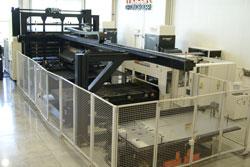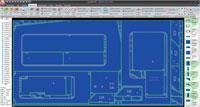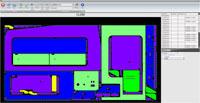Marketing Manager
- FMA
- The Fabricator
- FABTECH
- Canadian Metalworking
Categories
- Additive Manufacturing
- Aluminum Welding
- Arc Welding
- Assembly and Joining
- Automation and Robotics
- Bending and Forming
- Consumables
- Cutting and Weld Prep
- Electric Vehicles
- En Español
- Finishing
- Hydroforming
- Laser Cutting
- Laser Welding
- Machining
- Manufacturing Software
- Materials Handling
- Metals/Materials
- Oxyfuel Cutting
- Plasma Cutting
- Power Tools
- Punching and Other Holemaking
- Roll Forming
- Safety
- Sawing
- Shearing
- Shop Management
- Testing and Measuring
- Tube and Pipe Fabrication
- Tube and Pipe Production
- Waterjet Cutting
Industry Directory
Webcasts
Podcasts
FAB 40
Advertise
Subscribe
Account Login
Search
Nesting software keeps the “lights-out” on
Software features keep the lasers cutting through the night
- By Cornel TerreBlanche and John Leuzinger
- September 9, 2011
- Article
- Laser Cutting

Figure 1: Material movement is the key to “lights-out” manufacturing. This flexible manufacturing system delivers blanks to the laser cutting machine and then removes the laser-cut parts and skeleton when done, allowing the process to repeat. Photo courtesy of Mazak Optonics Corp.
A metal fabricating facility during the day is a noisy, bustling place. Lift trucks are zooming by, and CNC machines are cutting away. Production runs at full speed. Typically in the evening, however, the machines are shut down, and all grows quiet until the next morning. The machines could run longer hours, but the cost of keeping the facility staffed for a full late-night shift is not justified in today’s uncertain economy.
So how can a metal fabricator ensure that its overhead costs stay low while production capacity keeps up with the order book? The answer is “lights-out” manufacturing. In this scenario, a manufacturing facility relies on material handling automation to move blanks of sheet metal or plate onto the cutting bed of a CNC machine, usually a laser cutting machine, and to remove the skeleton and cut parts after the cutting is done. The entire process repeats itself once the previous job has been removed from the bed.
In the most advanced lights-out manufacturing environments, a flexible manufacturing system (FMS) (see Figure 1) comprises a single or a group of CNC machines, a storage tower for raw material inventory, and a line controller to coordinate the delivery of the blanks, the cutting job, and removal of the parts. The FMS approach also usually entails more advanced part-sorting options, instead of simply dropping cut parts in one single area.
On the other end of the spectrum is the use of a loader/unloader. This is typically used for a single machine on which the automation simply loads one sheet after another. This arrangement requires that the blank be stacked on the loader in the order it will be needed.
Of course, nothing is totally infallible. Even for those companies with the most advanced lights-out operations, the emergency phone call in the middle of the night to an equipment operator sometimes happens. A part might tip up and collide with the laser cutting head, or material inconsistencies may cause a cutting problem.
Advanced nesting systems (see Figure 2) can help prevent those scenarios and eliminate the late-night phone calls. Software features are designed to take steps to ensure potential collisions are avoided. Setting up a repeatable and consistent process is key, and if done correctly, the manufacturer can schedule the work in advance and run the cutting machine over an entire shift—and even over an entire weekend with the right combination of FMS and nesting software capabilities.
Avoiding the Chance of a Collision
The best way to avoid a collision is to avoid the situation that leads to a collision. Advanced nesting software identifies a cutting job’s characteristics that may lead to a tip-up and takes steps to avoid potential problem areas.
For example, for cutting contours, the nesting software determines the optimal lead-in and lead-out point for the cutting head, so it will be clear when the final cut is made on the part, steering clear of any potential tip-ups. The attempt to optimize the cutting flow also ensures the parts are cut quickly, keeping the head down and cutting as much as possible.
In general, nesting software attempts to keep the cutting head away from previously cut areas to avoid opportunities for tip-ups. In the event an optimized cutting path calls for a torch head to move over a cut area, instructions tell the head to retract sufficiently so that it can travel safely over the cut part.
Advanced software packages actually create a designated “halo” of a specific diameter around cut parts, so that that cutting head steers clear of the area not just over the part, but around the part as well. Some software packages allow machine operators to create their own fixed value for the halo manually. For instance, a CNC cutting machine with a contact head might require a larger-diameter halo than a noncontact cutting head.

Figure 2: A nest rarely contains just large, easy-to-handle parts. Smaller parts, such as those in this nest, are often in the mix and can pose a challenge when a fabricator wants to undertake lights-out manufacturing. Photo courtesy of SigmaTEK.
Tabbing Keeps the Parts Situated
This is probably the best way to avoid tip-ups: Keep the parts attached to the skeleton. Tabs help to do that.
Used mostly for small parts that can tip up with the slightest encouragement, tabbing is done automatically in nesting programs, with a little input from the machine operator. The operator provides the X and Y values—usually the width and length—that are the parameters for parts to be tabbed. When parts fall within those parameters, they get tabs, and vice versa.
Nesting programs also include manual overrides of dynamic nesting rules and predetermined operator parameters for problem parts, such as a long, thin part that risks falling into the slats after it has been cut. An operator can go into the software and dictate that tabs are placed on this particular part anytime it is cut.
Tabbing requirements also are thickness- and material-dependent in most nesting programs.
Sorting It All Out
The algorithms in a nesting program will automate much of the decision-making related to collision avoidance and tabbing, but that’s not the end of how the software can help fabricators run lights-out operations. Nesting software also can help sort parts.
With most software packages, the person responsible for sorting parts from the skeleton can reference a visual image on the computer screen and use that to separate parts onto assigned pallets. The graphical layout of the sheet on the computer screen likely contains a part number, which can help differentiate two similar-looking parts.
Some advanced nesting software might have more than the simple part number to help with sorting efforts. A feature such as a color-coded graphic of the nest (see Figure 3) can simplify and speed up the offloading process. Each different part is colored differently, making it easier to identify all of the parts, even those that might look the same.
So not only can advanced nesting software keep the automated fabricating operations up and running, it also can help with the back-end part organization. The software is a valuable tool for those metal fabricators that find the only way they can be competitive is with their automation investment (see Figure 4).
About the Authors
Cornel TerreBlanche
445 Kemper Meadow Drive
Cincinnati, OH 45240-1637
513-674-0005
John Leuzinger
Director, Consulting Services
1445 Kemper Meadow Dr.
Cincinnati, OH 45240-1637
513-674-0005
Related Companies
subscribe now

The Fabricator is North America's leading magazine for the metal forming and fabricating industry. The magazine delivers the news, technical articles, and case histories that enable fabricators to do their jobs more efficiently. The Fabricator has served the industry since 1970.
start your free subscription- Stay connected from anywhere

Easily access valuable industry resources now with full access to the digital edition of The Fabricator.

Easily access valuable industry resources now with full access to the digital edition of The Welder.

Easily access valuable industry resources now with full access to the digital edition of The Tube and Pipe Journal.
- Podcasting
- Podcast:
- The Fabricator Podcast
- Published:
- 04/16/2024
- Running Time:
- 63:29
In this episode of The Fabricator Podcast, Caleb Chamberlain, co-founder and CEO of OSH Cut, discusses his company’s...
- Trending Articles
AI, machine learning, and the future of metal fabrication

Employee ownership: The best way to ensure engagement

Steel industry reacts to Nucor’s new weekly published HRC price

Dynamic Metal blossoms with each passing year

Metal fabrication management: A guide for new supervisors

- Industry Events
16th Annual Safety Conference
- April 30 - May 1, 2024
- Elgin,
Pipe and Tube Conference
- May 21 - 22, 2024
- Omaha, NE
World-Class Roll Forming Workshop
- June 5 - 6, 2024
- Louisville, KY
Advanced Laser Application Workshop
- June 25 - 27, 2024
- Novi, MI



























